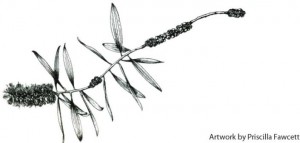COMMON NAMES
Paper bark
HISTORY OF INTRODUCTION
Melaleuca was introduced outside its native habitat of Australia over a century ago. It was originally brought to Florida and eventually the Bahamas as an ornamental plant. Due to its nature of being able to drain water from small areas, it began to drain wetlands and starve native plants of food and light. Due to this deprivation, the Melaleuca has and continues to displace the native vegetation throughout the Bahamas.
DESCRIPTION
The evergreen ever invasive Melaleuca with its narrow trunk and thick whitish peeling bark can grow to be 85 feet tall. The long normally 3 inch-leaves are stiff and dull with veins that run parallel to each to each other. The many flowers stand rigid on the branch tips and are densely packed giving it a bottle- brush look. It produces seeds that are tiny and brown which are contained in small rounded capsules crowded on twigs.
HABITAT
Melaleuca can grow in many different habitats but thrives in moist to saturated areas such as wetlands, lakes and the ocean. Also known as Cajeput, Paperbark and Punk tree, Melaleuca is said to be resistant to salt as well as natural disasters which is why it was used as an ornamental plant. These same properties make it an aggressive invader and a huge threat to native plants. Melaleuca Artwork by Priscilla Fawcett Invasive Species of the Bahamas
SCIENTIFIC NAME
Melalauca quinquenervia FAMILY Myrtaceace
DISTRIBUTION
In addition to being native to Australia, it is also home in New Guinea and New Caledonia. It can also be found in tropical to subtropical wet and humid climate which is climate similar to Australia’s.
REPRODUCTION
Melaleuca plants reproduce at remarkable speeds. On an average one of many spikes that make up one flower can produce about 30 seeds. A single capsule can bear up to 300 seedlings which are released when the tree is threatened by fire, strong wind and even pruning.
CONSERVATION CONCERNS
Native plant species in The Bahamas are especially vulnerable to the introduction of this invasive species. As the native plants are incapable of adapting quick enough to respond to aggressive invaders it is very easy for our susceptible flora to be wiped out by Melaleuca.
INTERESTING FACTS
The name melaleuca is derived from the Greek words for “black” and “white” referring to a familial species that has a black stem and white branchlets. “Quinquenervia” refers to the usual 5 veins of the leaves.
